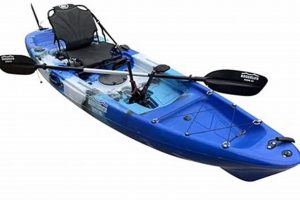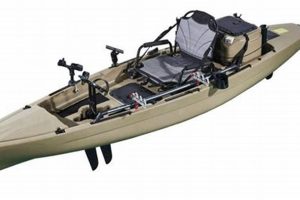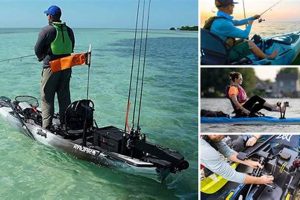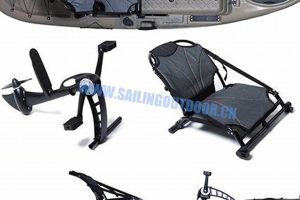Human-powered kayak propulsion systems for angling fall into two main categories: fin-based systems operated by the legs, and bladed systems operated by the arms. Fin-driven kayaks offer hands-free fishing and often greater speed and efficiency over longer distances, while paddle-driven kayaks provide maneuverability in tight spaces, shallow water, and areas with underwater obstructions. Each method presents distinct advantages and disadvantages for the angler depending on fishing style and environmental conditions.
The choice of propulsion dramatically impacts a fishing kayak’s performance and the angler’s experience. Historically, paddles were the sole means of propulsion. However, the development of pedal-driven systems has expanded angling opportunities, allowing fishers to cover more water with less effort and keep their hands free for casting and landing fish. This evolution has also led to specialized kayak designs, optimizing hull shapes and seating positions for each propulsion type.
The following sections will explore the specific advantages and disadvantages of each propulsion method in detail, considering factors such as speed, stability, maneuverability, cost, maintenance, and suitability for different fishing environments. Furthermore, the discussion will cover key features to consider when selecting a fishing kayak based on preferred propulsion type.
Tips for Choosing Between Pedal and Paddle Kayaks
Selecting the right propulsion system for a fishing kayak requires careful consideration of individual needs and fishing styles. The following tips offer guidance in navigating this decision.
Tip 1: Evaluate Fishing Environments: Pedal kayaks excel in open water and larger bodies of water where covering distance efficiently is paramount. Paddle kayaks are better suited to shallows, vegetated areas, and rapidly changing water conditions where maneuverability is key.
Tip 2: Consider Physical Capabilities: Anglers with limited upper body strength may find pedal kayaks less physically demanding. Conversely, individuals who prioritize core workouts may prefer paddling.
Tip 3: Prioritize Hands-Free Fishing: Pedal drives offer the significant advantage of hands-free fishing, allowing for continuous casting and quicker reaction times to strikes.
Tip 4: Assess Budgetary Constraints: Pedal kayaks generally carry a higher price tag due to the more complex drive systems. Paddle kayaks offer a more affordable entry point into kayak fishing.
Tip 5: Factor in Maintenance Requirements: Pedal drives, particularly fin-based systems, require more maintenance and occasional repairs compared to the simpler mechanics of a paddle.
Tip 6: Test Before Purchasing: Whenever possible, test both pedal and paddle kayaks before making a purchase. This allows for a firsthand experience of the advantages and disadvantages of each propulsion system.
Tip 7: Research Specific Models: Different pedal and paddle kayak models offer varying levels of performance, features, and stability. Thorough research is crucial for selecting the optimal kayak for specific fishing needs.
By carefully evaluating these factors, anglers can make informed decisions and choose the propulsion system that best aligns with their fishing styles, physical capabilities, and budgetary considerations.
The subsequent section will summarize the key differences between pedal and paddle fishing kayaks and offer final recommendations for prospective buyers.
1. Propulsion Method
Propulsion method forms the core differentiator between fundamental fishing kayak types. Selection significantly impacts performance characteristics and influences angling tactics. Two primary propulsion methods dominate the market: human-powered fin drives operated by the legs, and traditional paddles operated by the arms. This choice directly affects speed, maneuverability, and overall fishing experience.
Fin-driven propulsion systems, commonly referred to as pedal drives, provide several advantages. These systems allow anglers to cover greater distances with less physical exertion, particularly beneficial in open water or when targeting pelagic species. The hands-free operation afforded by pedal drives allows for continuous casting and faster reaction times when fish strike. However, fin drives can be more susceptible to damage in shallow water or areas with submerged obstacles. Examples include propeller-based systems known for speed, and fin-based systems recognized for their weedless operation in heavily vegetated areas. Conversely, paddle propulsion offers superior maneuverability in tight confines, enabling access to shallow creeks, mangrove tunnels, and areas dense with underwater structure. Paddling offers a full-body workout and allows for quick changes in direction. While efficient for short distances, paddling can be more tiring over long periods and requires alternating between paddling and fishing activities. Examples of paddle designs include asymmetrical blades for efficient strokes and feathered blades for reduced wind resistance.
Understanding the nuances of each propulsion method is crucial for maximizing fishing effectiveness and overall enjoyment on the water. Considerations include target species, fishing environment, physical capabilities, and budgetary constraints. While fin drives offer speed and hands-free operation, paddles provide maneuverability and affordability. Matching propulsion method to specific fishing needs and personal preferences is key for a successful kayak angling experience.
2. Speed and Efficiency
Speed and efficiency represent critical performance metrics when evaluating propulsion systems for fishing kayaks. The chosen method paddle or pedal directly impacts how quickly and efficiently an angler can traverse the water, influencing both fishing success and overall experience. Pedal-driven systems, particularly those utilizing fins or propellers, generally offer higher speeds and greater efficiency over longer distances compared to traditional paddling. This advantage stems from the biomechanics of leg-powered propulsion, allowing for sustained, powerful strokes and reduced fatigue. For instance, an angler targeting offshore fishing grounds or covering extensive stretches of a reservoir benefits significantly from the speed and efficiency of a pedal kayak, reaching distant spots faster and conserving energy for fishing.
Conversely, paddle propulsion prioritizes maneuverability over sustained speed. While paddling allows for rapid acceleration and directional changes, maintaining high speeds over long distances requires considerable physical exertion. This method proves advantageous in environments demanding precise navigation, such as shallow creeks, mangrove forests, or areas choked with vegetation. For example, an angler fishing tight quarters in a river system benefits from the maneuverability of a paddle kayak, navigating complex currents and obstacles effectively, even at the expense of outright speed. Efficiency in such scenarios translates to the angler’s ability to precisely position the kayak for optimal casting and fish retrieval, rather than covering vast distances.
Ultimately, prioritizing speed and efficiency depends on the specific fishing application and the angler’s individual needs. Open water angling necessitates speed and endurance, making pedal drives a compelling choice. Maneuverability reigns supreme in confined or obstacle-rich environments, favoring paddle propulsion. Understanding this trade-off between speed/efficiency and maneuverability allows anglers to select the optimal propulsion system for their targeted fishing style and environment, maximizing both on-the-water effectiveness and enjoyment.
3. Maneuverability
Maneuverability represents a critical performance characteristic differentiating pedal and paddle-powered fishing kayaks. This attribute dictates the ease and precision with which a kayak navigates various water environments, directly impacting angling effectiveness. Paddle kayaks, propelled by human arm and torso movement, offer superior maneuverability compared to their pedal-driven counterparts. The direct, instantaneous control over paddle strokes allows for rapid directional changes, precise positioning, and efficient navigation through complex obstacles. Consider navigating a narrow, winding creek choked with fallen logs: a paddle kayak allows the angler to execute quick turns and precise movements, essential for avoiding obstructions and accessing prime fishing spots. Conversely, pedal-driven kayaks, while offering advantages in speed and hands-free operation, possess inherent limitations in maneuverability. Their reliance on underwater fins or propellers necessitates wider turning radii and reduces responsiveness in tight quarters. Such limitations can hinder navigation in complex environments like shallow, vegetated areas or swiftly flowing streams demanding rapid adjustments.
The impact of propulsion choice on maneuverability extends beyond simple navigation. It directly influences fishing tactics and success. In situations requiring precise boat control, such as presenting lures near submerged structures or maintaining position in flowing currents, paddle kayaks offer distinct advantages. Imagine a scenario where an angler targets fish holding tight to bridge pilings: the precise control of a paddle enables delicate adjustments to position the kayak for optimal casting angles, maximizing lure presentation and minimizing snag potential. Pedal kayaks, while enabling hands-free fishing, might struggle to maintain precise positioning in such scenarios due to their turning radius limitations. Furthermore, propeller-driven pedal kayaks pose risks in shallow, obstacle-laden environments, potentially damaging the propulsion system on submerged rocks or logs.
Selecting the appropriate propulsion system based on maneuverability needs requires careful consideration of target fishing environments. Open water or large reservoirs, where maneuverability is less critical, favor pedal kayaks for their speed and efficiency. Conversely, rivers, creeks, mangrove tunnels, or any environment requiring tight turns and precise positioning benefit significantly from the maneuverability afforded by paddle kayaks. Understanding this trade-off between maneuverability and other performance characteristics, such as speed and hands-free operation, empowers anglers to choose the optimal propulsion system aligned with their specific fishing style and target environment.
4. Hands-free Fishing
Hands-free fishing represents a significant advantage offered by pedal-driven kayaks, fundamentally altering the angling experience compared to traditional paddle propulsion. This capability stems from the utilization of leg-powered fin or propeller systems, eliminating the need for hand-held paddles and freeing both hands for fishing tasks. The impact of this hands-free operation extends beyond mere convenience; it directly enhances fishing effectiveness and efficiency. Consider the scenario of working a lure through a promising stretch of water: a pedal kayak angler can maintain precise lure control with one hand while simultaneously preparing a second rod or adjusting tackle with the other. A paddle kayak angler, conversely, must interrupt lure retrieval to reposition the kayak, potentially disrupting the presentation and missing strike opportunities.
The benefits of hands-free fishing become particularly pronounced in specific angling situations. Fighting a strong fish, for example, demands constant adjustments to rod position and line tension. In a pedal kayak, the angler maintains full control of the rod and reel with both hands, maximizing leverage and minimizing the risk of line breakage. Simultaneously, the angler can reposition the kayak using leg power, keeping the fish away from obstacles or maintaining optimal fighting angles. Landing a fish also becomes significantly easier with both hands available for netting or gripping the fish. In contrast, a paddle kayak angler faces the challenging task of balancing paddling, rod manipulation, and landing the fish, often requiring awkward maneuvers and increasing the likelihood of losing the catch. Furthermore, hands-free operation allows for quicker reaction times when a fish strikes, setting the hook more effectively and reducing the chance of the fish throwing the lure.
While hands-free fishing offers undeniable advantages, acknowledging the trade-offs inherent in pedal-driven systems remains crucial. Maneuverability in tight quarters, shallow water access, and initial cost represent key considerations. Paddle kayaks retain their dominance in environments demanding precise navigation and affordability. However, for anglers prioritizing casting efficiency, fighting larger fish effectively, and maximizing overall fishing time, the hands-free operation afforded by pedal kayaks represents a significant advancement, enhancing both performance and enjoyment on the water.
5. Physical Demands
Physical exertion inherent in kayak fishing varies significantly depending on the chosen propulsion system pedal or paddle. Understanding these physical demands is crucial for selecting the appropriate kayak type for individual fitness levels, preventing injuries, and maximizing on-the-water enjoyment. Each propulsion method engages different muscle groups and presents unique challenges, necessitating careful consideration of physical capabilities and potential strain.
- Upper Body Endurance (Paddling)
Paddle kayaks predominantly engage upper body muscles, including shoulders, back, and arms. Sustained paddling, especially against currents or wind, requires significant upper body strength and endurance. Anglers opting for paddle propulsion should assess their fitness level and prepare for potential fatigue during longer trips. Regular paddling practice and strength training can mitigate these challenges.
- Lower Body Strength (Pedaling)
Pedal kayaks primarily utilize leg muscles for propulsion. While reducing strain on the upper body, pedaling engages quads, hamstrings, and calves. Anglers with pre-existing knee or leg conditions should carefully evaluate pedal kayaks before extended use. Proper seating position and pedal adjustment are crucial for minimizing strain and maximizing efficiency.
- Core Engagement (Both Methods)
Maintaining balance and stability in a kayak, regardless of propulsion method, requires significant core engagement. Strong core muscles are essential for preventing fatigue and maintaining proper posture, contributing to both comfort and safety. Regular core strengthening exercises are beneficial for all kayak anglers.
- Repetitive Motion Strain
Both paddling and pedaling involve repetitive motions, potentially leading to overuse injuries. Proper form, stretching, and taking breaks are crucial for minimizing strain on joints and muscles. Anglers should be mindful of potential discomfort and adjust their technique or take rest periods as needed.
Careful consideration of these physical demands, coupled with an honest assessment of personal fitness levels, ensures informed decision-making when selecting between pedal and paddle kayaks. Matching physical capabilities to propulsion method optimizes on-the-water comfort, prevents injuries, and ultimately contributes to a more enjoyable and successful fishing experience. Prioritizing proper paddling or pedaling technique, engaging in regular exercise, and understanding potential strain specific to each propulsion system allows anglers to fully enjoy the physical and rewarding aspects of kayak fishing.
6. Maintenance Requirements
Maintenance requirements differ significantly between pedal and paddle-powered fishing kayaks, impacting long-term performance, durability, and overall cost of ownership. Paddle kayaks, with their simpler mechanical design, generally require less frequent and less complex maintenance. Regular rinsing with fresh water after each use, occasional lubrication of moving parts, and periodic inspection for wear and tear typically suffice. Damage to paddles, while possible, is usually readily apparent and relatively easy to repair or replace. Conversely, pedal-driven kayaks, incorporating more complex propulsion systems, necessitate more diligent and specialized maintenance. Fin drives, for example, require regular cleaning to remove debris like weeds, fishing line, or sand, which can impede performance or cause damage. Moving parts, including chains, gears, and bearings, necessitate periodic lubrication and inspection. Saltwater environments, particularly corrosive, demand even more meticulous rinsing and preventative maintenance to protect metallic components. Propeller-based systems, while generally efficient, are susceptible to damage from impacts with submerged objects, necessitating occasional repairs or replacements.
Neglecting proper maintenance can lead to decreased performance, premature wear, and potentially costly repairs. A fin drive clogged with vegetation, for instance, can significantly reduce propulsion efficiency and place undue stress on the drive system. Similarly, failing to lubricate moving parts in a pedal drive can lead to increased friction, wear, and eventual failure. Regular maintenance not only prolongs the lifespan of the kayak’s components but also ensures optimal performance and safety on the water. Understanding the specific maintenance needs of each propulsion system, including recommended cleaning procedures, lubrication schedules, and inspection protocols, empowers kayak anglers to protect their investment and enjoy trouble-free operation. This knowledge also factors into the overall cost comparison between pedal and paddle kayaks, as the higher initial cost of pedal drives can be offset by the lower maintenance requirements of paddles over the long term.
Ultimately, recognizing the distinct maintenance demands associated with each propulsion system allows for informed decision-making during the kayak selection process. Anglers prioritizing simplicity and minimal upkeep might favor paddle kayaks, while those willing to invest time and effort in regular maintenance may opt for the performance advantages offered by pedal drives. Balancing maintenance requirements against other factors like fishing style, target environment, and budget ensures the chosen kayak aligns with individual needs and provides years of reliable service on the water.
7. Cost Considerations
Cost represents a significant factor influencing the decision-making process when selecting a fishing kayak. The choice between pedal and paddle propulsion directly impacts the initial investment, as well as potential long-term expenses associated with maintenance, repairs, and upgrades. Understanding the cost implications of each propulsion system is crucial for informed decision-making and aligning budgetary constraints with desired features and performance characteristics.
- Initial Purchase Price
Pedal kayaks typically command a higher initial purchase price compared to paddle kayaks due to the more complex manufacturing and engineering involved in their propulsion systems. The inclusion of drive mechanisms, fins or propellers, and specialized seating arrangements contributes to increased production costs. Paddle kayaks, relying on simpler construction and readily available paddles, offer a more budget-friendly entry point into kayak fishing. This price difference can range significantly, influencing affordability and accessibility for various consumer budgets.
- Maintenance and Repairs
Long-term cost considerations extend beyond the initial purchase price. Pedal kayaks, with their more intricate propulsion systems, often require more frequent and specialized maintenance compared to paddle kayaks. Regular cleaning, lubrication, and occasional replacement of parts like fins, propellers, or drive components contribute to ongoing expenses. Paddle kayaks, conversely, involve minimal maintenance, primarily limited to paddle care and occasional hull repairs. This difference in maintenance requirements translates to varying long-term cost implications, influencing overall ownership expenses.
- Accessories and Upgrades
Both pedal and paddle kayaks offer opportunities for customization and upgrades, further influencing overall costs. Accessories like fish finders, rod holders, anchors, and specialized seating can add significant expense to either kayak type. Pedal kayaks may also offer upgrade options for higher-performance drive systems or enhanced features, further increasing potential investment. Careful consideration of essential accessories and potential upgrade desires allows for accurate budgeting and prevents unexpected expenses.
- Resale Value
Resale value represents another cost consideration, particularly for anglers anticipating future upgrades or changes in fishing style. Pedal kayaks, due to their higher initial cost and specialized features, often retain better resale value compared to paddle kayaks. This factor can partially offset the higher initial investment, potentially making pedal kayaks a more financially sound long-term option for anglers who frequently change or upgrade their equipment.
Balancing initial purchase price, long-term maintenance costs, potential accessory expenses, and anticipated resale value against desired features and performance characteristics allows anglers to make informed decisions aligned with their budgetary constraints. Recognizing the cost implications associated with each propulsion system pedal or paddle empowers informed choices and maximizes long-term satisfaction with the chosen fishing kayak.
Frequently Asked Questions
This section addresses common inquiries regarding the choice between pedal and paddle propulsion for fishing kayaks. Clear, concise answers provide prospective buyers with the information necessary to make informed decisions.
Question 1: Which propulsion system is faster?
Generally, pedal-driven kayaks, particularly those with fin or propeller systems, achieve higher speeds over longer distances compared to paddle-driven kayaks.
Question 2: Which system offers better maneuverability?
Paddle kayaks offer superior maneuverability in tight spaces, shallow water, and areas with obstacles due to direct control over paddle strokes. Pedal kayaks have wider turning radii.
Question 3: Which system is better for fishing in shallow water?
Paddle kayaks are generally preferred for shallow water fishing due to their maneuverability and reduced risk of damaging underwater propulsion systems.
Question 4: What are the maintenance requirements for each system?
Paddle kayaks require minimal maintenance, primarily rinsing and occasional lubrication. Pedal kayaks necessitate more frequent cleaning, lubrication, and potential part replacements.
Question 5: Which system is more expensive?
Pedal kayaks typically have a higher initial purchase price due to the complexity of the drive systems. Long-term costs can vary depending on maintenance and repair needs.
Question 6: Which propulsion system is better for beginners?
The best system for beginners depends on individual preferences and intended fishing locations. Paddle kayaks offer a lower entry cost and simpler operation, while pedal kayaks provide hands-free fishing but require a larger initial investment.
Careful consideration of these frequently asked questions, along with individual fishing needs and preferences, facilitates informed decision-making when selecting a fishing kayak.
For further inquiries or personalized recommendations, consulting with experienced kayak anglers or specialized retailers is advisable.
Fishing Kayak Pedal or Paddle
Careful evaluation of fishing kayak propulsion systems pedal versus paddle reveals distinct advantages and disadvantages associated with each. Pedal-driven mechanisms prioritize speed, efficiency, and hands-free fishing, proving advantageous in open water and long-distance travel. Paddle propulsion excels in maneuverability and affordability, making it ideal for navigating complex environments like shallows, rivers, and areas requiring precise boat control. Factors influencing the optimal choice include target fishing locations, physical capabilities, maintenance considerations, and budgetary constraints. Comprehensive understanding of these elements empowers anglers to select the propulsion system best suited for individual needs and fishing styles.
Ultimately, the decision between a fishing kayak propelled by pedal or paddle mechanisms hinges on a nuanced assessment of individual priorities and intended usage. This considered choice significantly impacts on-the-water effectiveness, comfort, and overall fishing experience. As kayak fishing continues to evolve, further advancements in propulsion technologies promise enhanced performance and specialized features, offering anglers even greater choice and customization in pursuing their passion.






